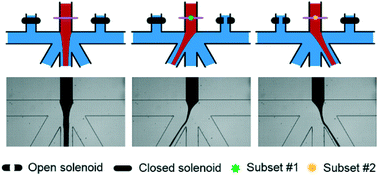Simultaneous and selective isolation of multiple subpopulations of rare cells from peripheral blood using ensemble-decision aliquot ranking (eDAR)†
Abstract
Rare cells, such as circulating tumor cells (CTCs), can be heterogeneous. The isolation and identification of rare cells with different phenotypes is desirable, for clinical and biological applications. However, CTCs exist in a complex biological environment, which complicates the isolation and identification of particular subtypes. To address this need, we re-designed our ensemble-decision aliquot ranking (eDAR) system to detect, isolate, and study two subpopulations of rare cells in the same microchip. With this dual-capture eDAR device, we simultaneously and selectively isolated two subsets of CTCs from the same blood sample: One set expressed epithelial markers and the other had mesenchymal characteristics. We could apply other selection schemes with different sorting logics to isolate the two subpopulations on demand. The average recovery rate for each subpopulation was higher than 88% with a nearly 100% selectivity of the targeted cells; the throughput was 50 μL min−1.


 Please wait while we load your content...
Please wait while we load your content...